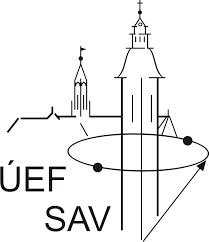Stopped experiment
| CDF A study of high energy collisions of protons with antiprotons on Tevatron at energy 1.8 and 1.96 TeV | ||
| Accelerator Taking data: Department participation: | Tevatron Fermilab 1992-2011 from year 1993 | |
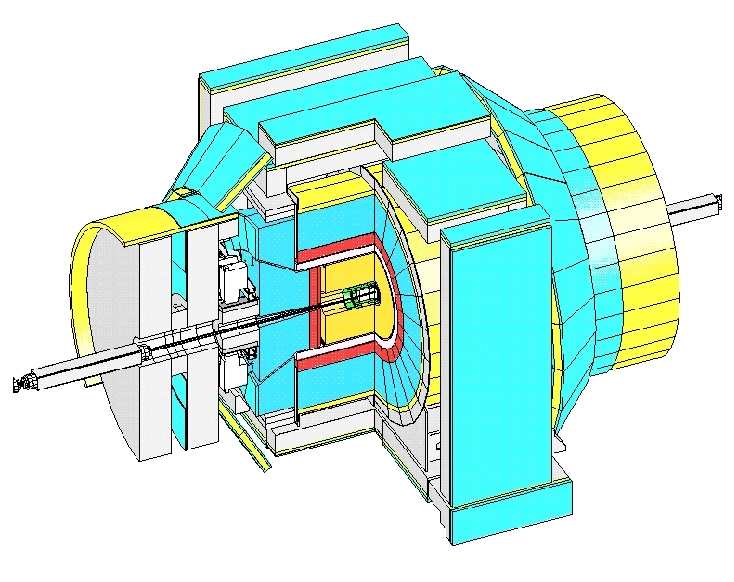 |
Main results of the CDF experiment: The biggest result of the CDF collaboration is the discovery of the top quark in 1995. The next effort was focused to more precise measurement of the top quark mass, necessary to specify the range, where the Higgs mass have to occur. The CDF experiment, in additionn to the top physics, was focused also to b-quarks physics, to W and Z boson physics, to the physics of electroweak interactions, to search of the Higgs boson and manifestation of exotic supersymmetric particles. More about the experiment CDF | |
The contribution of Košice CDF group to the experiment:
| ||
- Top mass
- Cross-section dependent top mass
- Top charge
- Asymmetry in top production
- Top spin
- Higgs boson study
Top mass
|
The top quark is possibly the most fascinating particle, because it is the heaviest elementary particle. The top quark mass, a fundamental parameter of the Standard Model that must be measured experimentally, is of great interest because of its large value and the constraints it places on the Higgs boson mass. This correlation between the two particles prompts us to measure the mass of the top quark as precisely as possible.
Most current methods attack the problem of measuring the top quark mass by fitting distributions and seeing which mass fits the data best. A novel approach by CDF physicists incorporates the additional information that the lighter the mass of the top quark, the more top quarks produced. Therefore, counting the number of top quark candidates provides a constraint on the top quark mass itself. But they did not stop here. The physicists also looked into one of the hardest channels to understand, the one that results in neutrinos in the final state. Neutrinos fly through our detectors without being noticed, leaving the "signal" of such a top decay consisting of a large amount of missing information. |
|
|
At the Tevatron, top quarks are primarily produced in pairs and decay to a W boson and b quark. The "dilepton" channel includes events where both W bosons decay leptonically; it has low statistics but little background contamination.
The mass measurement in this channel provides direct confirmation that the observed excess of events is due to the Standard Model top quark; a significant discrepancy compared to measurements in other channels could indicate contributions from new sources. |
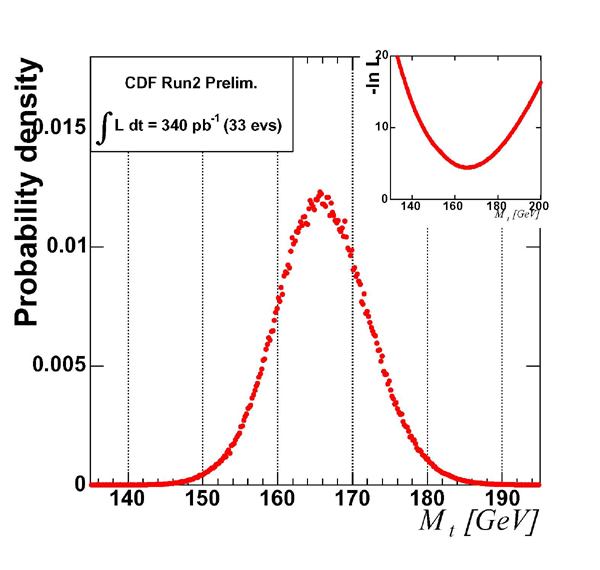
|
| Researchers from the Department of Subnuclear Physics, Jaroslav Antoš a Roman Lysák, working at CDF have developed new technique of top mass measurement in dilepton channel. The reconstruction of the top mass in these events is a tough business, because a large amount of information is lost due to nonregistred neutrinos from W decay. Values for the missing information are chosen from distributions in simulated events and used to calculate a most likely top mass for each event. |
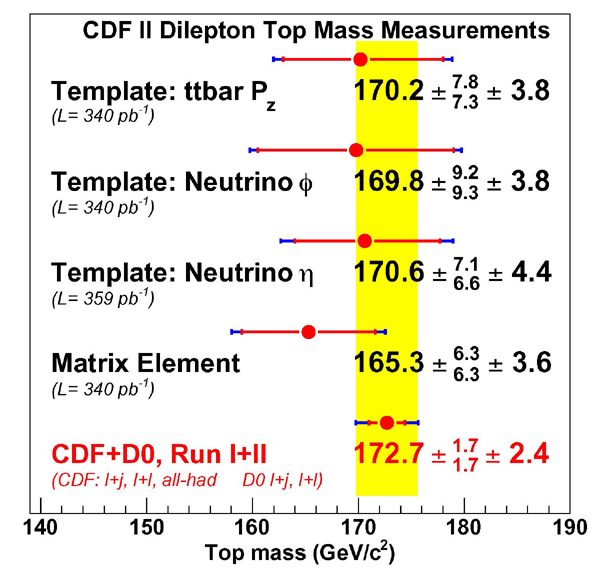
|
|
Learn more: Top Mass Measurement in Dilepton Channel using Pzttbar (Kinematic Method) |
|
Back to top
Measuring top mass using cross-section constraint
|
A new method for measuring top quark
mass using cross-section constraint have developed Jaroslav Antoš a Roman Lysák.
The relationship predicted by theory matches the measured top mass and cross-section. The top mass is consistent with all other measurements from CDF, but more importantly the technique provides a more precise measurement than the traditional approach of using a fitting procedure alone. |
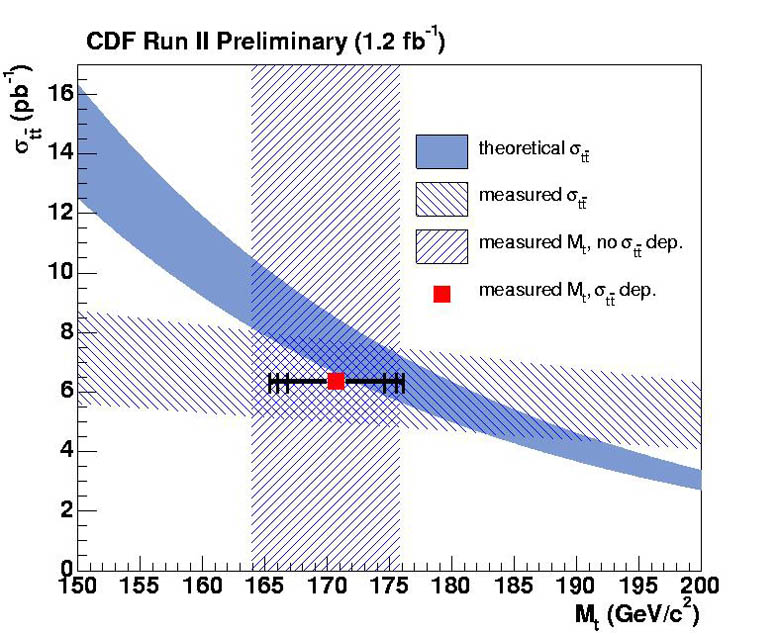
|
|
Learn more: Cross-section Dependent Top Mass Measurement in Dilepton Channel using Pzttbar (Kinematic Method) |
|
Back to top
Top charge
|
Since the discovery of the top quark, CDF has measured several properties of those events to confirm that the top quark has the properties expected in the standard model. Measuring its electric charge would help answer that question.
According to the Standard Model, the top quark should have a charge of +2/3 and should decay to a W+ (charge +1) and a b quark (charge -1/3), while the anti-top should decay to a W- (charge -1) and an anti-b quark (charge +1/3). The charge of the W can be obtained from the charge of the electron or muon it decays into, but what about distinguishing between a b quark and an anti-b quark? |
|
|
A team of CDF physicists, among them also Jaroslav Antoš, answer this question by summing the charges of all the tracks inside a b jet. If the sum comes out positive, they assign the jet to an anti-b quark, and if it is negative, to a b quark. Using this algorithm, they estimate that they make the correct assignment about 60% of the time. This is a tough business!
The CDF physicists find that with about 1 inverse femtobarn of data, the Standard Model hypothesis for the top quark is strongly supported. |
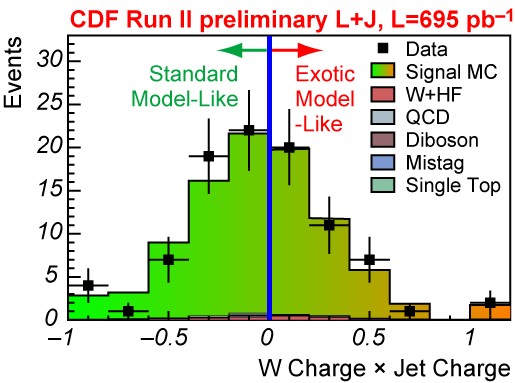
|
|
Learn more: Measuring the sign of the top charge using the top decay products |
|
Back to top
Asymmetry in top pair production
|
Symmetries have long been an important part of characterizing physical laws. Although some of the most beautiful theories exhibit symmetric properties. Indeed, studies of weak nuclear reactions in the 1960's led to the discovery of parity violation, and a deeper understanding of electromagnetism and the weak force.
Current theory predicts that the strong force, the force that binds quarks together, should exhibit only symmetric properties. The CDF experiment has tested discrete symmetries of the strong force by studying top quark events produced by the Tevatron. Top quarks are produced at the Tevatron dominantly through the strong force. They are the most massive known particle, and have properties that some theories suggest may be related to electroweak symmetry breaking and the Higgs boson. The Tevatron is a highly suitable experiment to study the symmetry of producing top quarks. As it collides protons with anti-protons the collision is asymmetric. |
|
|
Previous research by the CDF experiment found evidence of a larger asymmetry than the Standard Model leads us to expect, which could be evidence of a new particle just out of reach at the Tevatron’s collision energy.
Team of physicists from CDF (Jaroslav Antoš) have developed a method of reconstructing top anti-top events in the dilepton channel and applied this to a measurement of the front-back asymmetry in top production in 5.1 fb-1 of proton-antiproton collisions at √s = 1.96 TeV. The measurement is a test of charge asymmetry in the strong interaction at large momentum transfer. In the present work, the front-back asymmetry is measured to be: Afb = 42 +/- 16 percent, which is 2.6 sigma from zero and 2.3 sigma from the Standard Model expectation. This exciting result provides further evidence of a larger than expected asymmetry in top quark production. |
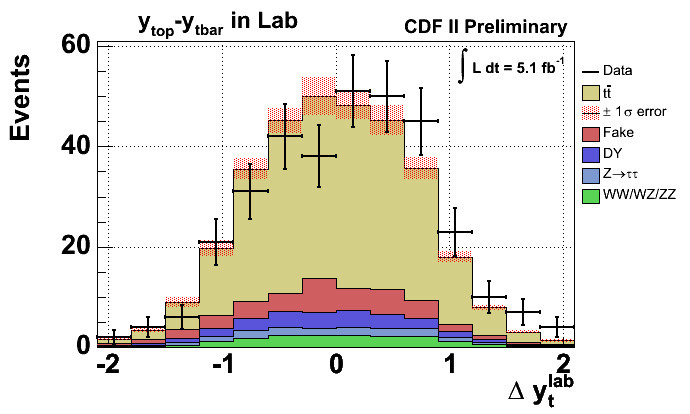
|
|
More on: Measurement of the Forward Backward Asymmetry in Top Pair Production in the Dilepton Decay Channel using 5.1 fb-1 |
|
Back to top
Top spin
|
According to Standard Model the top quark decays very fast with the lifetime of about 5×10−25s. Short lifetime prevents the hadronization of top quark, therefore its properties are transferred directly to decay products without modification. Standard Model makes specific prediction about W boson polarization in case of top decay to W and b-quark. Precise measurement of W polarization fractions could reveal new physics beyond the Standard Model.
The top quark decays almost immediately into a W boson and a bottom quark.Thus in a top-anti-top event, two Ws are produced – one from each quark. The W is identified by its subsequent decay into an electron or a muon and a neutrino. This relatively rare decay of top and anti-top into muons or electrons, two neutrinos and two bottom quarks, known as a top dilepton event, can be reconstructed. |
|
|
From the reconstruction we determine the rotational states of the W, of which there are three possibilities. They are the right-handed state, where the motion of the W particle and its spin are in the same direction; left-handed, where the motion of the W particle and its spin are in the opposite direction; and longitudinal, where the motion of the particle and its spin are perpendicular. The fractional probabilties of these three spin states must add up to one. Any given W can exist in only one state.
What is measured is essentially the angle between the direction of the momentum of the lepton and that of the top quark in the W boson's rest frame. |
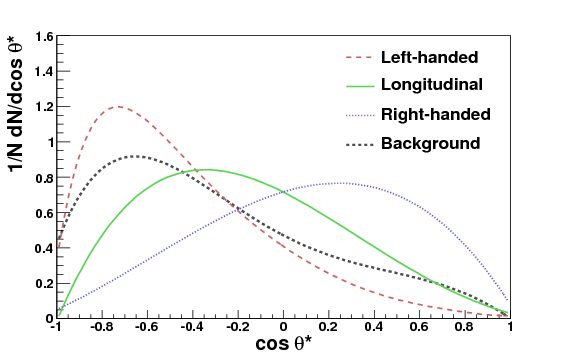
|
| Using 5.1 inverse femtobarns of data the CDF team (Jaroslav Antoš a Roman Lysák) find the probability that a W is observed in a longitudinal rotational state is 71 +18/-17%. The right-handed fraction is -7 ± 9%. We further find that at the 95% confidence level that the right-handed fraction is less than 7%. This is in very good agreement with the Standard Model prediction of a longitudinal fraction of 69.8% and a right-handed prediction of essentially zero. |
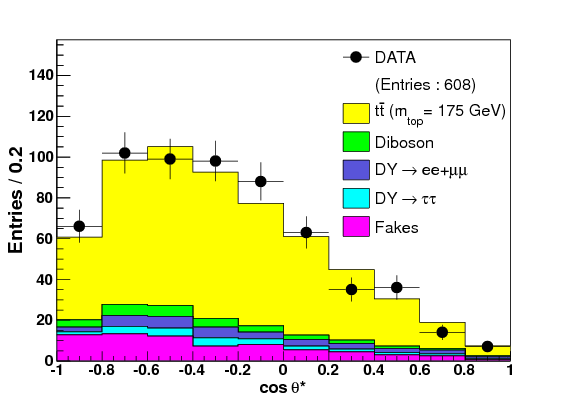
|
|
More on: Combination of the W boson polarization measurements from top quark decay using dilepton events with 5.1 fb−1 |
|
Back to top
Higgs boson study
|
A Higgs boson might help explain how particles gain mass. It would decay primarily into two W bosons. The W boson is one of two subatomic particles that mediate the weak force. The other particle is the Z boson. Double W production is an important Standard Model process to understand. But the WW final state is also interesting because of which particles might decay into it.
To find the signature of a Higgs boson to WW decay, scientists must first know very precisely how often double Ws are produced directly from other processes. CDF scientists took a break from their search for the Higgs boson to study what they consider a background -- the production of two W bosons that didn't come from the decay of a Higgs boson. In the process, they made the world's best measurement of how often these double Ws are produced in proton-antiproton collisions. |
|
|
By selecting from the same data and applying the same advanced analysis tools used for the Higgs search, CDF scientists (Roman Lysák) searched for WW events where each W decays to a lepton (electron or a muon) and a neutrino. They separated the true WW events from backgrounds using the measured information from the leptons and the missing energy, caused by neutrinos which escape the detector without interacting. Their measurement of WW production agrees well with theoretical predictions.
With this new, more precise measurement of WW production, CDF scientists demonstrate that they understand and can predict well the largest background for searches for a Higgs decaying to two W bosons. This result also validates that the advanced analysis tools used in the Higgs search work well when CDF scientists apply them to a known process. |
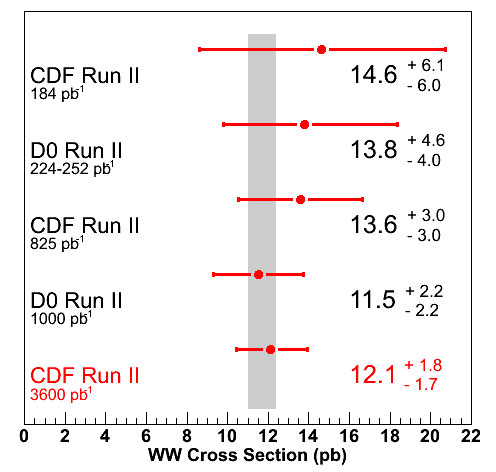
|
|
More on: Measurement of the WW Production Cross Section at CDF Using 3.6 fb−1 of Data |
|
|
If the Higgs exists, we are confident that it doesn't have a mass between 158-172 GeV.
CDF scientists (Roman Lysák) arrived at this result by isolating a subset of events that resemble those we expect to see from the Higgs. To do this, they simulated events that would originate from both a potential Higgs signal and each of the background processes we expected to contribute events to our search samples.
The plot shows H→WW sensitivity to the Standard Model Higgs Boson at CDF. The solid black line represents the maximum amount of Higgs boson production that could be hiding in the data, while the dashed line is the expected sensitivity if there is no Higgs boson production. When the sensitivity is less than one, it means that the analysis is sensitive to the Higgs boson. |
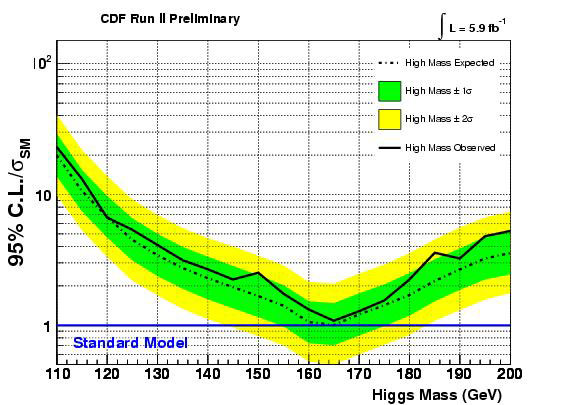
|
|
More on: http://theory.fnal.gov/jetp/talks/FNAL_HWW_WineAndCheese.pdf |
|
Back to top
